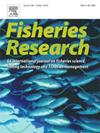The effects of light intensity and water clarity on growth rates of age-0 walleye (Sander vitreus)
IF 2.3
2区 农林科学
Q2 FISHERIES
引用次数: 0
Abstract
Growth rates in fish are a function of temperature and may also be dependent on successful foraging periods. Successful foraging of visually mediated piscivores is often contingent on available light. In north-temperate lakes, tannin concentrations can absorb downwelling light leading to lower light intensities which may influence fish foraging success and growth. We tested tannin and light intensity effects on wild age-0 walleye Sander vitreus growth, which may have implications for survivorship and recruitment. Age-0 walleye (127–182 mm TL) were held under three light intensities (3.16 × 1014, 3.16 × 1015, and 2.88 × 1017 photons m−2 s−1) and tannin concentrations (0 mg/L, 10 mg/L, and 20 mg/L). Walleye were grown at 18 °C for 16 days and TL (mm) and weight (g) were measured at days 0, 8, and 16. The number of fathead minnow (Pimephales promelas; 31–42 mm total length) consumed was recorded each day. Age-0 walleye growth was positive, ranging from 0.0092 g g−1 day−1 at 9.44 × 1015 photons m−2 s−1 (∼750 lx surface intensity) in clear water to 0.0223 g g−1 day−1 at 1.58 × 1015 photons m−2 s−1 (∼10 lx surface intensity) in heavily stained water. Growth was greatest in low light conditions and heavily stained waters. Our results suggest that heavily stained lakes and rivers with good optical refuge where light intensity is reduced at depth may be best for juvenile walleye growth.
光照强度和水浊度对0岁黄眼鱼生长速率的影响
鱼类的生长速度是温度的函数,也可能取决于成功的觅食期。视觉介导的鱼食性动物的成功觅食往往取决于可用的光线。在北温带湖泊中,单宁浓度可以吸收向下的光,导致光强降低,这可能影响鱼类的觅食成功和生长。我们测试了单宁和光照强度对野生年龄0岁的沙氏玻璃体生长的影响,这可能对生存和招募有影响。Age-0角膜白斑(127 - 182年 mm TL)举行了三下光强度(3.16 × 1014年3.16 × 1015和2.88 × 1017光子−2 s−1)和丹宁酸浓度(0 mg / L, 10 mg / L,和20 mg / L)。在18 °C的温度下培养16天,在第0、8和16天测量TL (mm)和重量(g)。黑头鲦鱼(Pimephales promelas;记录每天消耗的31-42 mm总长度)。Age-0角膜白斑发展是积极的,从0.0092 g g−−1天1 9.44 × 1015光子−2 s−1(∼750 lx表面强度)清水 0.0223 g g−−1天1 1.58 × 1015光子−2 s−1(∼10 lx表面强度)在严重沾水。在弱光条件和污染严重的水域生长最快。我们的研究结果表明,污染严重的湖泊和河流具有良好的光学避难所,在深度上光强降低可能最适合幼眼的生长。
本文章由计算机程序翻译,如有差异,请以英文原文为准。
求助全文
约1分钟内获得全文
求助全文
来源期刊

Fisheries Research
农林科学-渔业
CiteScore
4.50
自引率
16.70%
发文量
294
审稿时长
15 weeks
期刊介绍:
This journal provides an international forum for the publication of papers in the areas of fisheries science, fishing technology, fisheries management and relevant socio-economics. The scope covers fisheries in salt, brackish and freshwater systems, and all aspects of associated ecology, environmental aspects of fisheries, and economics. Both theoretical and practical papers are acceptable, including laboratory and field experimental studies relevant to fisheries. Papers on the conservation of exploitable living resources are welcome. Review and Viewpoint articles are also published. As the specified areas inevitably impinge on and interrelate with each other, the approach of the journal is multidisciplinary, and authors are encouraged to emphasise the relevance of their own work to that of other disciplines. The journal is intended for fisheries scientists, biological oceanographers, gear technologists, economists, managers, administrators, policy makers and legislators.
 求助内容:
求助内容: 应助结果提醒方式:
应助结果提醒方式:


